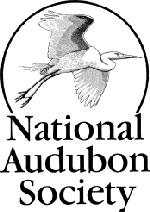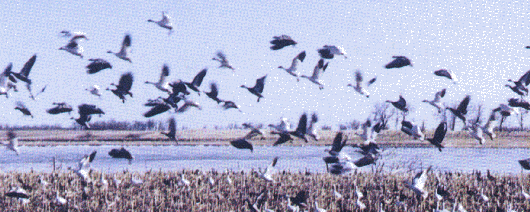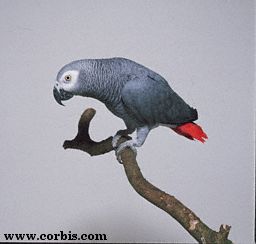
The mission of the National
Audubon Society is to conserve and restore
natural ecosystems, focusing on birds and other wildlife
for the benefit of humanity and the earth's biological diversity.

History

The mission of the National
Audubon Society is to conserve and restore
natural ecosystems, focusing on birds and other wildlife
for the benefit of humanity and the earth's biological diversity.

History
Wildlife faced a bleak future at the beginning of the 20th century.
George Bird Grinnell, editor of Forest and Stream, was one of the first to speak up against the mindless slaughter. In 1886 he encouraged his readers to join him in forming the country's first bird preservation organization, the Audubon Society. The society was named after the American naturalist and wildlife painter John James Audubon, who lived from 1785 to 1851. In only three months more than 38,000 people joined the society. Overwhelmed by the response, Grinnell had to disband the group in 1888.
A group of women appalled by the slaughter of birds formed the Massachusetts Audubon Society in 1896. They refused to buy or wear hats and clothing decorated with bird plumes or parts. They wrote letters to newspaper editors and spoke to politicians. Several months later the Pennsylvania Audubon Society was established, and by 1899, 15 other states had formed Audubon societies.
In 1899, Frank Chapman, an ornithologist with the American
Museum of Natural History in New York, began publishing Bird Lore
magazine, which became a unifying national forum for the Audubon movement.
Chapman sponsored the first national Christmas Bird Count in 1900. He felt
it was better to count birds than shoot them. Today more than 42,000 birders
participate in this annual census, and the data provides valuable information
to ornithologists.
In 1901, some of the Audubon Societies formed a loose alliance called the National Committee of the Audubon Societies. In 1905, they incorporated into the National Association of Audubon Societies for the Protection of Wild Birds and Animals. William Dutcher was elected the first president.
Audubon members worked to have important conservation laws passed. This included the New York State Audubon Plumage Law (1910) which banned the sales of plumes of all native birds in the state, and in 1918 the Federal Migratory Bird Treaty Act. As early as 1900, William Dutcher began hiring wardens to patrol important bird nesting sites. Three of these early wardens were killed in the line of duty by poachers.
Audubon encouraged the U.S. government to protect vital wildlife areas by including them in a National Wildlife Refuge system.
In the 1930s the Society began sponsoring scientific research projects on endangered birds such as the ivory-billed woodpecker and the roseate spoonbill. Today Audubon scientists use our sanctuaries as a point of comparison in studies on the effects of environmental degradation on ecosystems.
Media Coverage
Institutions
The Audubon Society
works with many other organizations and groups. They include: the
Department
of Energy, the U.S.
Department
of the Interior, the U.S. Environmental
Protection Agency, the U.S. Fish and Wildlife
Service, the National Park
Service,
and the Department of Agriculture.
Current Activities
NATIONAL:
Endangered Species Act: - protects endangered species.
Birds in the Balance - protects migration stopovers for birds
that go from North America that go from North America to Latin America.
Everglades Restoration - restore the ecosystem since much of
the Everglades water supply has been cut off.
Endangered Forests Campaign - fight to save the last ancient
forests in the Pacific Northwest and ecosystems in five other regions.
Wetlands Campaign - fighting the development of wetland
areas.
National Wildlife Refuges - ongoing home of hundreds of species
of animals and plants
Human Population and Resource Use - aiming to slow the explosive
growth of the human population and promote sustainable development the
world over
Living Oceans - focuses on the plight of the marine environment
and its wildlife
LOCAL
Bird Seed Sale Oct. 30: 22nd annual Bird Seed Sale
proceeds finance the Chicago Audubon Societys research committee projects
and their education programs in Chicago schools.
Field Trip to Indiana Dunes Nov. 7: trip to hopefully spot
rare waterfowl along the Lakefront.
Every Wednesday & Saturday in September and October: Paul
H. Douglas Nature Sanctuary Bird Walks.
Friday - November 12 at 7:30: ---Why Birds?--- presentation
by Donald Dann
People Involved:
National: www.audubon.org/nas/board/
Chicago Chapter
Officers:
President Jerry Garden
First Vice President Christine Lee
Second Vice President Sholom Gliksman
Secretary Karen Furnweger
Chairpersons:
Audubon Council of Illinois Al Rothebach
Audubon Hotline Doris Johanson
Awards Tony and Mary Mullen
Birdathon Jerry Garden
Bird Seed Sale, membership Al Rothenbach
Conservation Sheryl DeVore
Education Jeff Sundberg
Scholarships Joe Lukascyk
Field Trips Doris Johanson and Steven Lee
Illinois Environmental Al Council Rep Gene Small
Letter of the Month/Armchair Activist Jeffrey Rovner
Nominating, Land Stewardship Austin L. Wyman, Jr.
Programs Christine Lee
Publications Terri Likens
Publicity Bill Schwaber
Research Alan Anderson
Connections with other Organizations
Publications and other websites
In 1940, the society shortened its name to the National Audubon Society. The magazine Bird Lore was purchased in 1935 from the American Museum of Natural History, and its name changed to AUDUBON Magazine. In 1947, a technical ornithologist's journal was begun called Audubon Bird Notes -- now called Field Notes.
http://www.audubon.org/chapter/il/chicago/Compass.html
Impact on Nature
The goal of the Audubon
society is to preserve nature for everyone, so we can all enjoy it.
It current campaigns, as always,
center around preserving
nature. These projects include: preservation of wetlands, reauthorization
of the Endangered Species
Act, promoting a responsible
U.S. population policy, protecting America's endangered forests, protecting
and promoting
growth of America's
National Wildlife Refuges, conservation of marine wildlife, restoration
of water flows to enhance wildlife of
the Platte River system,
and protection of flight corridors for migratory birds.
And now
for some fun

Georgie Dubois 194?-1995
My Congo African Grey, Georgie, lived to be approximately 50-60 years old (we could only trace her life back to a certain point). For 30 years of her life she lived in a small cage without human touch and fed nothing but sunflower seeds and two peanuts a day (very bad diet). I first met George at my avian veterinarian (Dr. Hays) clinic. They were looking for a good home for her. I jumped at the chance and she came to live with us. I got her a huge cage, which she adored, and fed her a good diet (favorite: sweet potatoes) and was paid back a thousand fold. I miss her cuddles. I miss her chasing my husband to bite his feet. I miss her talking and whistling. I miss her intelligence. I miss her. She was the most wonderful bird in the world. She will always live on in my heart.
Sharon Dubois
Lucas, TEXAS
Send a card to your friends! Go to www.123greetings.com